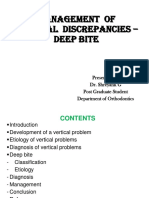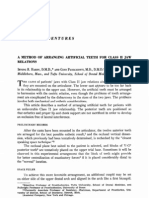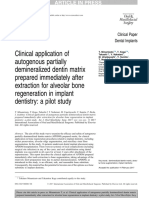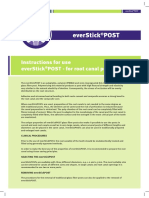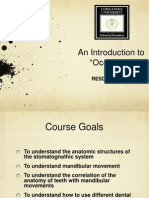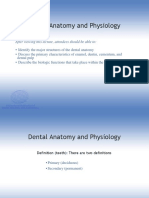Modified Functional Impression Technique For Complete Dentures
Modified Functional Impression Technique For Complete Dentures
Uploaded by
Dr.Maher MohammedCopyright:
Available Formats
Modified Functional Impression Technique For Complete Dentures
Modified Functional Impression Technique For Complete Dentures
Uploaded by
Dr.Maher MohammedOriginal Title
Copyright
Available Formats
Share this document
Did you find this document useful?
Is this content inappropriate?
Copyright:
Available Formats
Modified Functional Impression Technique For Complete Dentures
Modified Functional Impression Technique For Complete Dentures
Uploaded by
Dr.Maher MohammedCopyright:
Available Formats
See discussions, stats, and author profiles for this publication at: https://www.researchgate.
net/publication/7300597
Modified functional impression technique for complete dentures
Article in Brazilian Dental Journal · February 2005
DOI: 10.1590/S0103-64402005000200009 · Source: PubMed
CITATIONS READS
31 2,307
5 authors, including:
Helena de Freitas Oliveira Paranhos Cláudia Helena Silva-Lovato
University of São Paulo University of São Paulo
123 PUBLICATIONS 2,189 CITATIONS 145 PUBLICATIONS 2,398 CITATIONS
SEE PROFILE SEE PROFILE
Valdir Muglia
University of São Paulo
37 PUBLICATIONS 628 CITATIONS
SEE PROFILE
Some of the authors of this publication are also working on these related projects:
My research line is "Dental Clinic Research" more specifically aimed at the total edentulous individuals and dental materials for denture base, for bucomaxillofacial
prosthesis and ocular prosthesis View project
Improving practice guidelines for the treatment of denture-related erythematous stomatitis: a multicentre randomized controlled trial View project
All content following this page was uploaded by Cláudia Helena Silva-Lovato on 20 April 2015.
The user has requested enhancement of the downloaded file.
Braz Dent J (2005) 16(2): 135-139 Acrylic resin handle for final impression 135
ISSN 0103-6440
Modified Functional Impression Technique for
Complete Dentures
Alexandre MALACHIAS
Helena de Freitas Oliveira PARANHOS
Cláudia Helena Lovato da SILVA
Valdir Antônio MUGLIA
Carla MORETO
Department of Dental Materials and Prosthodontics, Faculty of Dentistry of Ribeirão Preto,
University of São Paulo, Ribeirão Preto, SP, Brazil
This report describes the use of a removable acrylic resin tray handle that can be easily attached to custom impression trays to produce
an improved peripheral sealing zone. This device can be indicated to develop functional impressions for complete dentures using the
patient-conducted muscular motion technique. In upper trays, the handle is fixed in the midline with acrylic resin, while in lower trays
the centrally positioned handle is removed before border molding. This removable handle allows patient’s suction and free tongue
movements. Final impression is carried out in two stages: peripheral sealing (low fusion compound) and recording of the main
supporting region of the denture (zinc oxide and eugenol paste). All border records are obtained from the patient’s own movements
(handle suction and tongue motion). The removable handle is simple to use, is reusable, can be adapted to any individual acrylic resin
trays and allows accurate registration of the peripheral sealing zone (border tissues).
Key Words: complete dentures, functional final impressions, removable anterior tray handle.
INTRODUCTION future denture base and the mucous membrane (7).
During the impression procedure, muscular zone
Stability of complete lower dentures has record can be achieved by either the dentist or the patient
challenged dentists and patients alike. In particular, “flat or both. Many dentists pull on the patient’s lips and
lower ridge” is associated with difficulties in providing cheeks to register the border areas (tissues surrounding
successful dentures (1,2). Resorption rates vary from the dentures) (8), which usually provides satisfactory
patient to patient and some authors have postulated border sealing zone (labial and buccal flanges). In the
several etiological factors related to residual (alveolar) technique where muscular zone record is obtained with
ridge resorption, ranging from localized pressure to the patient’s help, the patient is asked to make specific
systemic factors (3). muscular movements of the lips, cheeks, tongue and
Making accurate final impression for complete jaws (open/closure and lateral). The use of an individual
dentures is a multistage process that involves a preliminary tray is necessary for this technique. The borders of this
impression, a customized final impression tray and a tray should be established in such a way that the
final border impression (4,5). It is important to thoroughly patient’s muscular movements are free from them
examine the patient’s mouth and select the most during the impression procedure (9,10).
appropriate impression technique (1,6). A major This article describes the construction and use of
requirement for final impression of complete dentures is a removable functional acrylic resin handle that can be
to develop the peripheral contours to accommodate attached to custom impression trays, allowing an excellent
normal muscular function and to ensure peripheral peripheral sealing zone impression using a patient-
adaptation without allowing air penetration between the conducted muscular and jaw motion technique.
Correspondence: Profa. Dra. Helena de Freitas Oliveira Paranhos, Departamento de Materiais Dentários e Prótese, Faculdade de
Odontologia de Ribeirão Preto, USP, Avenida do Café, S/N, 14040-904 Ribeirão Preto, SP, Brasil. Tel: +55-16-3602-4006. e-mail:
helenpar@forp.usp.br
Braz Dent J 16(2) 2005
136 A. Malachias et al.
MATERIAL AND METHODS resin base (15 mm high with a 10-mm-diameter upper
central hole) should be prepared and fixed to the
Functional tray handles can be used with any individual tray on the residual ridge at its midline. The
individual acrylic resin trays. functional handle is further attached to the upper
These handles are made in a L-shaped metal central hole with a bolt that is 11 mm long and has a
master die (70 mm length and 7 mm in diameter), which diameter of 2 mm (Figs. 1 and 2).
is flasked in brass flasks (Safrany; J Safrany Dental This functional handle can be readily removed
metallurgy, São Paulo, SP, Brazil). After deflasking, the from the tray to facilitate molding of lingual and
heat-polymerized acrylic resin (Clássico Dental Products, sublingual flanges borders with low fusion impression
São Paulo, SP, Brazil) is pressed and molded according compound. The patient can freely move the tongue
to the manufacturer’s instructions to obtain the tray without interference from the tray handle. During this
handle. Thereafter, the handle is finished and polished. procedure, the tray is held in place by digital pressure
Once the individual tray is prepared, the handle can be of the dentist’s right and left index fingers on the
attached to its midline, positioned on the area acrylic resin supports existing in the region of the tray
corresponding to the crest of the ridge. corresponding to the first and second mandibular
For the maxillary arch, the handle can be fixed to premolar (Figs. 3 and 4). During impression of buccal
the tray using acrylic resin. For the mandible, an acrylic and labial flange borders, the functional handle is
Figure 2. Functional removable acrylic handle fixed with the
Figure 1. Functional removable acrylic resin handle, bolt, bolt to the central hole at the midline of the mandibular
individual impression tray with the lateral supports in the area impression tray (lateral view).
corresponding to the premolars/molars (upper view).
Figure 3. Mandibular individual impression tray held in position Figure 4. Patient’s tongue movement to provide impression of
during patient’s tongue movements to form the sublingual flange. the right lingual flange.
Braz Dent J 16(2) 2005
Acrylic resin handle for final impression 137
such a way that the patient can move his/her tongue
freely during the impression of the sublingual and lingual
flanges. The dentist uses the acrylic resin molar supports
at both sides of the tray, to keep it in position during this
phase of the impression procedure.
For vestibular border impression, the handle is
reattached to help introduce and hold the tray in place
into the mouth and to facilitate suction by the patient.
For lower impressions, during suction, the tray is
balanced by the dentist’s thumb pulling up and the index
finger pressing down, a procedure opposite to that used
for upper impressions.
As the border of the impression has been
Figure 5. Vestibular peripheral sealing zone record (labial and completed (Fig. 6), the next step is to record the main
buccal flanges), with the mandibular individual impression tray supporting surface of the final impression. The tray is
in position. Note the patient sucking on the functional handle loaded with zinc oxide-eugenol paste and gently seated
during the impression procedure. into the patient’s mouth. Once the tray is properly
positioned with the material overflowing, the handle is
reattached to the tray and the patient is asked to removed again for recording the lingual and sublingual
perform a suction movement (Fig. 5). flanges. At this time, the dentist keeps the tray in position
The adjustments on the custom impression tray by pressing the resin molar supports while the patient
are done based on its stability while seated in the performs tongue movements, as previously described,
patient’s mouth. The final impression is carried out in for approximately 20 s. Finally, the handle is quickly
two stages using two types of materials. The first stage reattached to the tray without removing the tray from
consists of border molding with low fusing impression the patient’s mouth and the patient is asked to repeat the
compound. In the second stage, a zinc oxide-eugenol suction movements with the operator firmly holding
paste is applied to the main supporting surface of the onto the tray handle.
impression. Using this final impression technique, border
molding is obtained by the patient’s own movements:
suction in the maxillary arch and tongue movements and
suction in the mandibular arch.
The upper tray is kept properly seated in position
by the operator’s thumb and index fingers. The handle
is rotated (down and up, respectively) during suction on
the handle to balance the tray loaded with impression
material, to effectively force all of the peripheral muscles
into maximum dynamic activity. The procedure does
not cause any discomfort to the patient. Posterior
border impression is enhanced using low fusion
impression compound, with the dentist firmly seating
the impression tray and pressing it against the central
Figure 6. Peripheral impression completed.
area of the palate. The impression is then completed
with zinc oxide-eugenol paste and the loaded tray is
gently seated in the patient’s mouth. The patient is asked DISCUSSION
to suck on the functional handle again, while the dentist
holds the tray in position. Complete denture impression can be defined as a
For lower border molding, the functional handle dynamic process that can be divided into two stages:
is removed from the base by disconnecting the bolt, in preliminary impression and final impression. The aim on
Braz Dent J 16(2) 2005
138 A. Malachias et al.
each patient is to fashion the impression surface and the can freely move the muscles, cheeks, lips and tongue
peripheral rolls of the complete dentures in such a way without interference of the tray handle or the dentist’s
that support, retention and stability of the denture are fingers. For individuals with an accentuated bone
maximized (11). These two stages compliment each resorption, for example, it is difficult to obtain good
other. The initial impression should resemble the basic retention and stability of the complete denture due to the
overall design for the complete denture. It also serves as presence of muscular insertions near the ridge crest or
the template for the final impression, helping to record border, which might cause muscular-induced
the borders (edges) and the base area of the complete displacement of the denture. In these cases, this
denture impression without distortion. During final functional technique is highly recommended. The degree
impression using this technique, the muscular tissues, of muscular activity and the region to which the denture
which may interfere with denture stability, can be can be extended without displacement are important
identified and allowed for their functional movements. aspects of any impression technique.
This warrants better border seal and improves retention The ordinary short tray handle used to guide the
and stability. tray into the mouth may present problems and make it
The peripheral sealing zone (border tissues) is an difficult to keep the tray in position. Suction around this
important region for denture retention and stability and type of custom tray handle is not easy and the tray can
should be precisely contoured during the final impression easily be dislocated. A possible solution would be to
procedure. The dentist should develop an accurate have the patient to suck on his/her own finger, but even
custom tray and use an effective material and border this procedure may unseat the tray. The problem could
molding technique. Several dynamic or functional be solved by asking the patient to suck the dentist’s
impression methods, which we believe are particularly finger, but this is embarrassing for both patient and
useful for patients with intense alveolar resorption, have dentist and may also cause tray displacement and
been reported (5,12,13). undesirable tissue displacement. On upper trays, if the
The characteristics of functional impression dentist pushes the handle up, the tray moves in a
techniques have not been widely investigated (14-16). It posterior direction; if the dentist pulls the handle
is common knowledge that each patient has his/her own backwards, tissue displacement in both the palate and
specific muscular activity. Sometimes the contraction the tuberosity regions can occur. With lower trays, the
of a muscle near its insertion can displace the denture, situation is aggravated because both the pushing down
unless it has a groove to accommodate such contractions. and pulling back movements may cause undesirable
Clinical evidence about the interfering muscle region tissue displacement in the anterior region or the tray may
that might affect denture stability is difficult to detect in move in a posterior direction.
some patients. Therefore, the dentist should attempt to The functional removable acrylic resin handle
record all these individual aspects of the patient’s labial hereby described offers a good support for correct
and buccal anatomy in the final impression in order to positioning of the custom tray in the patient’s mouth
permit normal muscle activity without loosing the denture causing neither displacement on any surface of interest
during function. for impression nor displacement of the tray.
The accuracy of complete denture impression The handle works as a suctioning device for the
techniques has been debated for many years. A wide patient and has the advantage of being removable on
diversity of denture border outlines, resulting from the lower trays, facilitating the full and accurate impression
use of the same impression procedure for all patients, of the sub-lingual flange region. To obtain a proper
has been shown and documented (17). Because each impression of this area, it is important to pay close
patient has his/her own distinct muscular strength and attention to the normal posture of the tongue (2,10,18,19)
anatomy, it is important to individualize peripheral sealing and it is necessary to seat the tray correctly, avoiding
zone impression. The functional handle was designed to any dislocation during tongue movements. This can be
effectively deal with this problem. Unlike other border achieved by removing the handle and holding the tray in
molding techniques, which use manual traction of soft place by pressing both lateral acrylic supports. In
tissues, the functional handle permits muscular addition, the lateral supports can provide an ideal pressure
movements during the final impression, i.e., the patient distribution during the impression procedure and an
Braz Dent J 16(2) 2005
Acrylic resin handle for final impression 139
unrestricted tongue access to most areas of interest. REFERENCES
This is difficult to accomplish with ordinary anterior
1 . McCord JF, Grant AA, Quayle AA. Treatment options for the
handles. edentulous mandible. Eur J Prosthodont Restor Dent
By sucking on the handle, the patient contributes 1992;1:19-23.
to settle the final border design, delineating the location 2 . Likeman PR. Tongue control of lower complete dentures: a
clinical hint. Br Dent J 1997;182:229-230.
of individual muscle insertions. An upper denture may
3 . Atwood DA. The reduction or residual ridges: a major oral
have some degree of movement during function even if disease entity. J Prosthet Dent 1971;26:266-278.
it does not exhibit any movement during clinical 4 . Heartwell CM, Rahn AO. Syllabus of complete dentures. 4th
examination. In fact, the characteristics of muscular ed. Philadelphia: Lea & Febiger; 1986.
5 . Zarb AZ, Bolender CL, Hickey JC, Carlsson GE. Boucher’s
insertion can easily be reproduced by using the suction prosthodontic treatment for edentulous patients. 10th ed. St
technique because the muscular records are obtained Louis: C V Mosby; 1990.
from the patient’s natural oral movements rather than by 6 . Grant AA, Heath JR, McCord JF. Complete prosthodontics:
problems, diagnosis and management. London: Wolfe; 1994
the dentist’s handling. Manual border molding is guided 7 . Suenaga K, Sato T, Nishigawa G, Minagi S. Relationship
by extrinsic forces that may hide traces or not reproduce between size of complete foundation area and resorption of
some functional movements when excessive manual alveolar ridge in the edentulous mandible. J Oral Rehabil
1997;24:315-319.
force is applied, which will over-shorten the flange
8 . Harvey WL, Brada BJ. An update of one-appointment master
height (20). impression an jaw relation record technique. Quintessence Int
Malachias and Paranhos (10) described a similar 1992;32:547-550.
functional handle made of metal. However, the acrylic 9 . Klein IE, Broner AS. Complete denture secondary impression
technique to minimize distortion of ridge and border tissues. J
resin removable functional handle, as described in this Prosthet Dent 1984;53:611-616.
paper, is easy-handling, rapidly produced, readily 10. Malachias A, Paranhos HFO. Functional metallic handles for
attached to custom impression acrylic trays, less costly final impressions of complete dentures. J Prosthet Dent
1998;79:607-608.
and available for all dentists in daily practice. Border 11. Jacobson TE, Krol AJ. A contemporary review of the factors
tissues are recorded directly from the patient’s functional involved in complete denture retention, stability and support.
movements (lips, tongue and cheeks), resulting in an J Prosthet Dent 1983;49:5-15.
12. Basker RM, Davenport JC, Tomlin RH. Prosthetic treatment
accurate individualized impression process and producing of the edentulous patient. 3rd ed. London: Macmillan; 1992.
excellent peripheral sealing. In our experience, it has 13. McCord JF, Tyson KW. A conservative prosthodontic option
worked well and yielded satisfactory results for patients of the treatment of edentulous patients with atrophic (flat)
mandibular ridges. Br Dent J 1997;182:469-472.
being treated by dental students.
14. Rapuano JÁ, Samanta A, Grieder A. Assuring successful
impression making in complete dental construction. Clin
RESUMO Prev Dent 1987;9:23-26.
15. Gilbert Y, Blandin M. Technique originale de prise démpreinte
Este trabalho descreve o uso de um cabo funcional removível em secondaire en prothèse adjointe complète (PAC). Rev.
resina acrílica que pode ser facilmente adaptado a moldeiras D’odonto-Stomatol 1991;20:9-19.
individuais para fornecer um bom registro da zona de selamento 16. Ivanhoe JR, Cibirka RM, Parr GR. Treating the modern
periférico. Este dispositivo pode ser indicado para moldagem complete denture patient: A review of the literature. J
final em prótese total utilizando a técnica de movimentação Prosthetic Dent 2002;88:631-635.
17. Woelfel JB, Hickey JC, Berg Tjr. Contour variations in one
muscular realizada pelo paciente. Em moldeiras superiores, o
patient’s impressions made by seven dentists. J Am Dent
cabo é fixado na linha mediana com resina acrílica, enquanto nas
Assoc 1963;67:22-29.
inferiores, a parte central do cabo é desmontável permitindo sua
18. Kotkin H, Slabebert JCG. Tongue position in relation to
remoção antes da moldagem dos bordos laterais. O cabo removível edentulous mandibular impressions. J Prosthet Dent
é passível de sucção pelo paciente e permite que a língua seja 1987;57:458-466.
movimentada livremente. A moldagem final é realizada em duas 19. Basker RM, Watson CJ. Tongue control of upper complete
fases: moldagem da zona de selado periférico (godiva de baixa dentures: a clinical hint. Br Dent J 1991;170:449-450.
fusão) e da superfície de suporte (pasta de óxido de zinco e 20. McArthur DR. Management of the mucolabial fold when
eugenol). Todos os registros musculares da zona de selado developing impressions for complete dentures. J Prosthet
periférico são obtidos por meio de movimentação muscular Dent 1985;53:62-67.
realizada pelo paciente (sucção do cabo e movimentação lingual).
O cabo funcional é reutilizável, permite um bom registro da zona Accepted November 26, 2003
de selado periférico (bordas teciduais) e pode ser adaptado a
moldeiras individuais de resina acrílica devido à sua facilidade e
simplicidade de uso.
Braz Dent J 16(2) 2005
View publication stats
You might also like
- The Subtle Art of Not Giving a F*ck: A Counterintuitive Approach to Living a Good LifeFrom EverandThe Subtle Art of Not Giving a F*ck: A Counterintuitive Approach to Living a Good LifeRating: 4 out of 5 stars4/5 (5976)
- The Gifts of Imperfection: Let Go of Who You Think You're Supposed to Be and Embrace Who You AreFrom EverandThe Gifts of Imperfection: Let Go of Who You Think You're Supposed to Be and Embrace Who You AreRating: 4 out of 5 stars4/5 (1110)
- Hidden Figures: The American Dream and the Untold Story of the Black Women Mathematicians Who Helped Win the Space RaceFrom EverandHidden Figures: The American Dream and the Untold Story of the Black Women Mathematicians Who Helped Win the Space RaceRating: 4 out of 5 stars4/5 (932)
- Elon Musk: Tesla, SpaceX, and the Quest for a Fantastic FutureFrom EverandElon Musk: Tesla, SpaceX, and the Quest for a Fantastic FutureRating: 4.5 out of 5 stars4.5/5 (476)
- Her Body and Other Parties: StoriesFrom EverandHer Body and Other Parties: StoriesRating: 4 out of 5 stars4/5 (831)
- The Emperor of All Maladies: A Biography of CancerFrom EverandThe Emperor of All Maladies: A Biography of CancerRating: 4.5 out of 5 stars4.5/5 (275)
- The Little Book of Hygge: Danish Secrets to Happy LivingFrom EverandThe Little Book of Hygge: Danish Secrets to Happy LivingRating: 3.5 out of 5 stars3.5/5 (424)
- The Yellow House: A Memoir (2019 National Book Award Winner)From EverandThe Yellow House: A Memoir (2019 National Book Award Winner)Rating: 4 out of 5 stars4/5 (99)
- Team of Rivals: The Political Genius of Abraham LincolnFrom EverandTeam of Rivals: The Political Genius of Abraham LincolnRating: 4.5 out of 5 stars4.5/5 (235)
- Application For Dental Office Employment: Experience and SkillsDocument3 pagesApplication For Dental Office Employment: Experience and SkillsAshley MarciganNo ratings yet
- On Fire: The (Burning) Case for a Green New DealFrom EverandOn Fire: The (Burning) Case for a Green New DealRating: 4 out of 5 stars4/5 (75)
- 2021 Batangas Medical Center - Updated Citizens Charter HandbookDocument447 pages2021 Batangas Medical Center - Updated Citizens Charter HandbookHarlyn MagsinoNo ratings yet
- 4.management of Vertical Discrepancies (2) 2Document97 pages4.management of Vertical Discrepancies (2) 2Arun Joy100% (2)
- Standard Edgewise 2.6.2020Document110 pagesStandard Edgewise 2.6.2020nikita100% (3)
- Never Split the Difference: Negotiating As If Your Life Depended On ItFrom EverandNever Split the Difference: Negotiating As If Your Life Depended On ItRating: 4.5 out of 5 stars4.5/5 (893)
- Shoe Dog: A Memoir by the Creator of NikeFrom EverandShoe Dog: A Memoir by the Creator of NikeRating: 4.5 out of 5 stars4.5/5 (545)
- Devil in the Grove: Thurgood Marshall, the Groveland Boys, and the Dawn of a New AmericaFrom EverandDevil in the Grove: Thurgood Marshall, the Groveland Boys, and the Dawn of a New AmericaRating: 4.5 out of 5 stars4.5/5 (270)
- A Heartbreaking Work Of Staggering Genius: A Memoir Based on a True StoryFrom EverandA Heartbreaking Work Of Staggering Genius: A Memoir Based on a True StoryRating: 3.5 out of 5 stars3.5/5 (232)
- The Hard Thing About Hard Things: Building a Business When There Are No Easy AnswersFrom EverandThe Hard Thing About Hard Things: Building a Business When There Are No Easy AnswersRating: 4.5 out of 5 stars4.5/5 (356)
- Grit: The Power of Passion and PerseveranceFrom EverandGrit: The Power of Passion and PerseveranceRating: 4 out of 5 stars4/5 (619)
- The World Is Flat 3.0: A Brief History of the Twenty-first CenturyFrom EverandThe World Is Flat 3.0: A Brief History of the Twenty-first CenturyRating: 3.5 out of 5 stars3.5/5 (2272)
- The Unwinding: An Inner History of the New AmericaFrom EverandThe Unwinding: An Inner History of the New AmericaRating: 4 out of 5 stars4/5 (45)
- The Sympathizer: A Novel (Pulitzer Prize for Fiction)From EverandThe Sympathizer: A Novel (Pulitzer Prize for Fiction)Rating: 4.5 out of 5 stars4.5/5 (124)
- My New ResumeDocument2 pagesMy New Resumeapi-353714249No ratings yet
- Complete Dentures: Irving Hardy, AND Passamonti, ofDocument5 pagesComplete Dentures: Irving Hardy, AND Passamonti, ofShreyans DamadeNo ratings yet
- CV Examples-ADocument8 pagesCV Examples-AMargarita SerebrennikovaNo ratings yet
- Revision of The American Association of Dental Research's Science Information Statement About Temporomandibular Disorders - JcdaDocument7 pagesRevision of The American Association of Dental Research's Science Information Statement About Temporomandibular Disorders - JcdaProfa Luciana GuimarãesNo ratings yet
- Principles of Tooth Preparation Part-7Document1 pagePrinciples of Tooth Preparation Part-7Popper DyNo ratings yet
- Original Research PaperDocument2 pagesOriginal Research PaperАнна ШаповаловаNo ratings yet
- Jurnal BitewingDocument6 pagesJurnal BitewingWidi PrabowoNo ratings yet
- Dental Decks - DentalAnatomy-OcclusionDocument78 pagesDental Decks - DentalAnatomy-OcclusionXiid DNo ratings yet
- Adg 2Document8 pagesAdg 2alfasrasimp123No ratings yet
- 10 1016@j Prosdent 2018 02 021Document4 pages10 1016@j Prosdent 2018 02 021Felipe Barrera CastroNo ratings yet
- New Post Technique Hand-Out PDFDocument2 pagesNew Post Technique Hand-Out PDFDarshilNo ratings yet
- Chapter 2 Dental ClinicDocument5 pagesChapter 2 Dental ClinicJunard Dominguez100% (1)
- Intro To OcclusionDocument17 pagesIntro To OcclusionrusschallengerNo ratings yet
- Cambra Guide 2019 PDFDocument10 pagesCambra Guide 2019 PDFMaximiliano Jara ContrerasNo ratings yet
- Brochure Handpieces InstrumentsDocument28 pagesBrochure Handpieces InstrumentsKukinjosNo ratings yet
- Mechanics To Enhance EstheticsDocument21 pagesMechanics To Enhance EstheticsTolly CNo ratings yet
- Bds Third Year Test - Docx 2013Document6 pagesBds Third Year Test - Docx 2013Samina TarikNo ratings yet
- Pulp Calcifications in Primary TeethDocument3 pagesPulp Calcifications in Primary TeethNguyễn QuỳnhNo ratings yet
- Complaint Letter To KSDC President About Excess FeesDocument4 pagesComplaint Letter To KSDC President About Excess FeesRoopesh L RNo ratings yet
- All SmilesDocument5 pagesAll Smilesanmol vermaNo ratings yet
- Dental Anatomy and PhysiologyDocument36 pagesDental Anatomy and PhysiologyCpt.WnchstrNo ratings yet
- Periodontal InstrumentDocument10 pagesPeriodontal Instrumentama_rubNo ratings yet
- An Impression Technique For Patients With Fixed Orthodontic AppliancesDocument2 pagesAn Impression Technique For Patients With Fixed Orthodontic Appliancesmoji_puiNo ratings yet
- How To Care For Your New Denture or Partial DentureDocument2 pagesHow To Care For Your New Denture or Partial DentureAmalia R. SholichahNo ratings yet
- 02 - 02 - Oral and Maxillofacial Surgery - enDocument2 pages02 - 02 - Oral and Maxillofacial Surgery - enamirmahdi82.s.fNo ratings yet
- IncisorsDocument46 pagesIncisorsharnageaNo ratings yet























